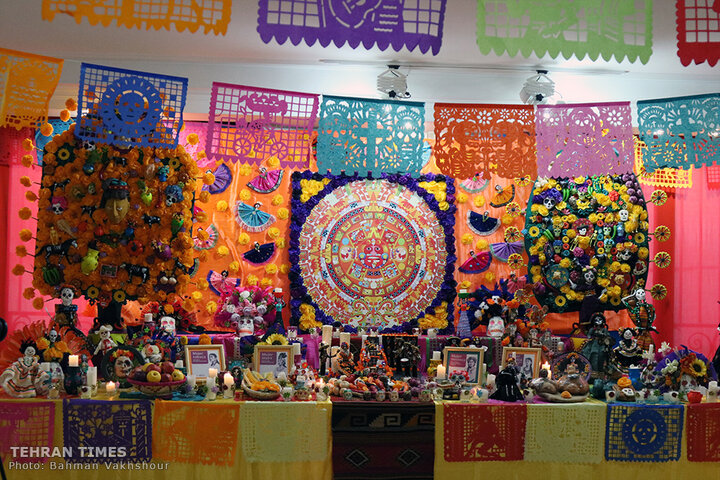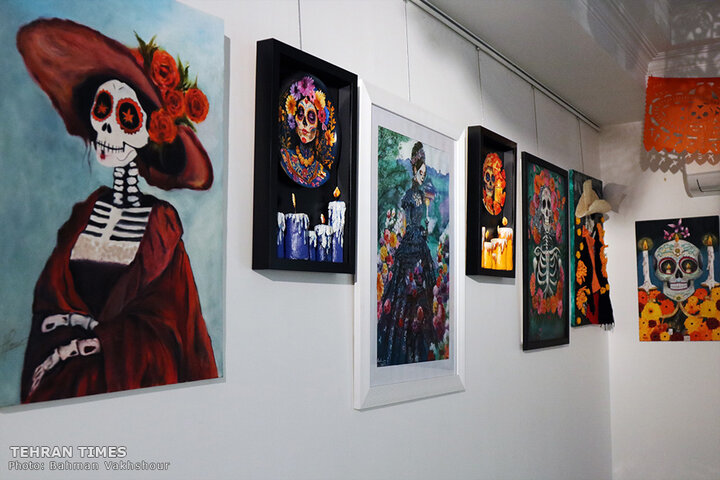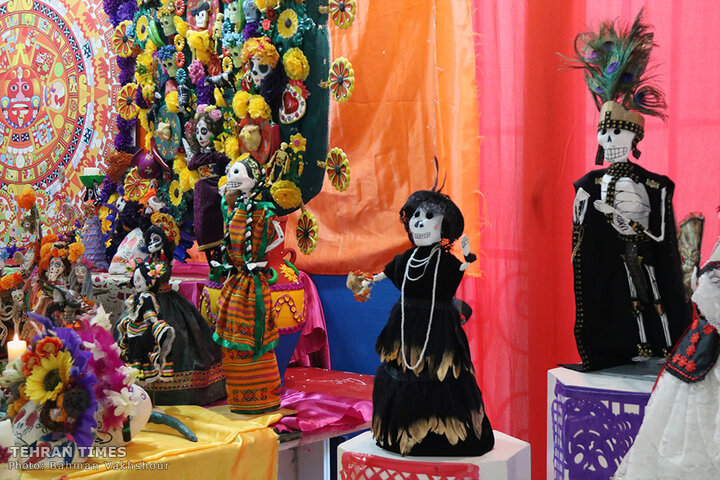Mexican Embassy in Tehran celebrates Day of the Dead with visual arts exhibition by Iranian artists

TEHRAN – The Mexican Embassy in Tehran held a visual arts exhibition from November 3 to 11 to celebrate the tradition of the Day of the Dead.
Held in collaboration with the Tehran Visual Arts Association, the exhibition showcased 40 works of art across various fields, including painting, illustration, graphic design, and sculpture, all created by Iranian artists on the subject of the Day of the Dead, one of Mexico’s most beloved traditions, filled with color, flowers, scents, and memories.
In an exclusive interview with the Tehran Times, the Ambassador of Mexico in the Islamic Republic of Iran, Guillermo Puente Ordorica, explained the Mexican tradition of the Day of the Dead and details of this year’s exhibition.
“The Day of the Dead in Mexico is an ancient tradition. Over the years, especially after the arrival of the Spanish and the influence of Catholicism, it blended with pre-Hispanic beliefs. In the original Indigenous worldview, death was considered a natural part of life — a cycle. One moment you are in this world, and a moment later, you are in the next world, but you are still able, symbolically, to return. It is a continuous renewal,” the ambassador elaborated.
“To be part of this cycle, of course, you must pay respect to your loved ones so they do not feel forgotten. They should feel remembered and loved. Every year, particularly on November 2, we believe we have the chance to call on them and give them an opportunity to symbolically return to our world. It has become a national celebration in Mexico,” he added.
“The Day of the Dead is perhaps one of the most iconic cultural celebrations in Mexico — certainly among the top ones. It represents profound social and cultural values. If you look at the colors and the different artistic expressions surrounding this celebration, you’ll see that they originate from popular traditions and manifestations,” he emphasized.
The tribute to death celebration in November of each year represents one of Mexico's most deeply rooted traditions, a tradition that has been practiced for over 500 years.
The Day of the Dead is an ancient Aztec celebration of the memory of deceased ancestors that is celebrated on November 1 and 2. The holiday involves family and friends gathering to pay respects and remember friends and family members who have died.
When asked if this celebration has been spread to other countries, Guillermo Puente Ordorica said: “Over the years, UNESCO declared the Day of the Dead part of the Intangible Cultural Heritage list. Today it is widely recognized, and Mexicans all around the world celebrate it”.

The holiday is especially popular in Mexico, where it is a national holiday. It is also celebrated in the Philippines, in Mexican-American communities in the United States, and to a lesser extent, in other Latin American countries, especially by people of Mexican heritage.
Traditions connected with the holiday include honoring the deceased using calaveras and marigold flowers, building altars with the favorite foods and beverages of the departed, and visiting graves with these items as gifts for the deceased.
However great the variation may be among the altars of the different regions, certain elements are always present: water, salt, flowers, and candles. Water relinquishes the souls’ thirst and refreshes the path to the beyond. Salt is an invitation to the banquet and serves to purify its essence. Candle symbolizes the souls of our departed loved ones, and the vivid yellow and orange color represent light and the sun, which assist the souls not to lose their way in returning home. It is also a tradition to lay a carpet of flowers from the altar to the street so that the dead find their way towards the altar.
Speaking about the similarities between the Mexican tradition and the ways to remember the loved ones in Iran and other countries, the ambassador said: “I’ve noticed, through conversations with colleagues and other ambassadors, that many countries have similar traditions in which people honor their deceased loved ones. In Iran, I discovered that during certain periods—close to the New Year, if I’m not mistaken—people visit cemeteries, bring flowers, share food or drinks, and spend time symbolically with those who have passed away. This shows that the idea of remembering loved ones is universal, not only Mexican”.
“Other than visiting cemeteries, the Iranians also remember loved ones throughout the year. I find this very meaningful. It shows that Iranians, like Mexicans, maintain a deep connection with both life and death, and with the people they love — whether they are still alive or have passed away. It also reflects the importance both societies place on family structures and emotional bonds,” he noted.
Referring to the exhibition at the site of the embassy, the Mexican ambassador said: “This year, we decided to collaborate with Iranian schools, universities, cultural centers, and institutions that teach Spanish in Iran. We also invited artists and creators who were interested in participating”.
“The Iranian people have an extraordinary artistic sense, and this year the Tehran Visual Arts Association collaborated with us. They enthusiastically organized a contest, receiving around 400 artworks. Then, a jury of three Iranian artists selected 40 pieces, which we are exhibiting now,” he stated.

According to the ambassador, “another important aspect of this year’s program was the workshops we organized in the months leading up to the exhibition. Iranian participants, guided by an Iranian teacher, created Catrina dolls — one of the most iconic symbols of the Day of the Dead. What we discovered is that Iran has its own rich tradition of handmade dolls, so the idea was to merge the Mexican concept of Catrina dolls with Iranian craftsmanship. The result, as you can see, is fascinating: Catrina dolls made with Iranian techniques and materials”.
Catrina is a recurring figure in Mexican visual arts, depicted as a lively skeleton wearing a large plumed hat associated with early 20th-century upper-class European women’s fashion. It was first created by Mexican printmaker José Guadalupe Posada in the early 20th century and became an icon in Mexico through her popularization by artists such as Mexican muralist Diego Rivera and a traveling art exhibition during World War II.
The skeletons depict individuals from all classes and occupations, which scholars have interpreted as symbolic of a macabre egalitarianism, suggesting that regardless of status, death comes for all.
Catrina has become a national symbol of modern Mexico. Her unmistakable visage and hat are reproduced in various forms at the Day of the Dead celebrations. Altars to the deceased often feature figurines of Catrina.
A significant part of this year’s exhibition is the dedication of the Altar of the Dead to the women of great pre-Hispanic civilizations. Elaborating on this issue, the ambassador said: “As you may know, Mexico recently, for the first time in more than 200 years of our history as an independent country, elected its first female President. So, this year is a celebration of that achievement”.

“Additionally, in Mexico, the year 2025 has been declared the ‘Year of the Indigenous Women’. Combining these themes, we decided to dedicate our altar to four extraordinary women from Mexico’s major ancient civilizations, each representing a different cultural tradition. They are not the only significant women in our history, but they are also highly symbolic. Through them, we want to share with the Iranian people both the richness of these civilizations and the central role women played in them,” he underlined.
They include the Mexica woman: Tecuichpo (Isabel Moctezuma), Maya woman: The Red Queen, Mixtec woman: Lady 6 Mono (Huachino), and Toltec woman: Xiuhtzatzin (Little Toltec Flower).
Daughter of Moctezuma II, Tecuichpo was a key figure in Mexica history. Her name means “cotton flower” or “white flower”. During her lifetime, she witnessed the fall of Tenochtitlán and survived the tumultuous period of the Spanish conquest, becoming a symbol of resistance and cultural adaptation, maintaining her noble lineage while facing the drastic changes imposed by the conquerors.
Consort of the celebrated ruler Pakal, the Red Queen was a queen of the city of Palenque who marked her time with her influence and sacredness. She was revered as a divine figure, reflecting her relevance in the Maya dynasty.
Lady 6 Mono, born in Jaltepec in 1073, was a prominent queen, ruler, warrior, and empire builder in the Mixtec world of Oaxaca.
The first Toltec queen, Xiuhtlaltzin ascended the throne after the death of her husband Mitl in 1035. Her brief four-year reign set a precedent in Toltec history, notable for her conciliatory nature and her role as protector of her husband's legacy
SS/SAB
Leave a Comment